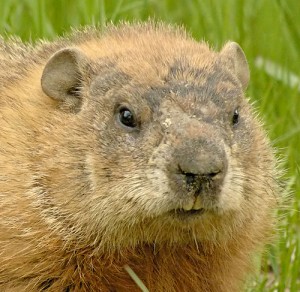Woodchuck Description and Habitats

Woodchucks range in size from 20” to 27” long, excluding the tail, weighing 5 to 12 lbs. Woodchucks are grizzled brown on the top part of their coat, some with blackish or rufous tones and they are buffy below. Ears are short, rounded and their face has pale puffy patches. Legs are short and powerful and their tail is bushy. They give a shrill whistle, followed by a chuck, chuck. They are diurnal, most active in the early morning and evening. They rely on dew as their water source. Woodchucks have good eyesight, and are good swimmers. They’ll climb trees up to a height of about 20 ft, but most commonly keep it to 8–12 ft. Hibernates deeply from the time of the first heavy frost through early spring. Occasionally hibernates in small groups. Skunks and Woodchucks are known to populate holes together. They do not migrate. Woodchucks breed from February through March, having young in late March to early May. Woodchucks are herbivores, eating succulent grasses, weeds, clover, fruits (such as apples, cherries, pears), berries, field and garden crops and ornamental plants.
Woodchuck Damage and the Health Hazards
If there is one animal that we seem to encounter that truly drives our customers crazy it’s the Woodchuck. We have heard countless stories of these little furry adorable creatures reeking havoc on gardens, crops and the foundations of your sheds, barns and decks. Woodchucks are commonly seen basking in the sun, in a grassy area, on a fence post, stonewall, large rock or fallen log, always near its burrow. Woodchucks burrow and their tunnels can end up costing you significant amounts of money to repair if they have chosen to dig and burrow into your properties foundation. Woodchucks are carriers of mange and raccoon roundworm. As with all wildlife, Wildlife Busters recommends that human contact be avoided and left to a professional.
Woodchuck Removal Services
Wildlife Busters provides humane Woodchuck trapping and removal services. However, the best way to avoid a nuisance wildlife circumstance with a woodchuck is trench prevention.
Trench prevention is Wildlife Busters way of keeping any type of trenching (digging nuisance wildlife) animal out of from underneath certain structures. It allows us to give our customers a long-term solution to a problem that for many years was controlled simply by trapping. Trapping these animals is still widely used by professionals in our industry and is often used by Wildlife Busters in combination with trench prevention. Our trenching services come with a written warranty of 1 to 3 years.

 Receive FREE wildlife Tips!
Receive FREE wildlife Tips!
